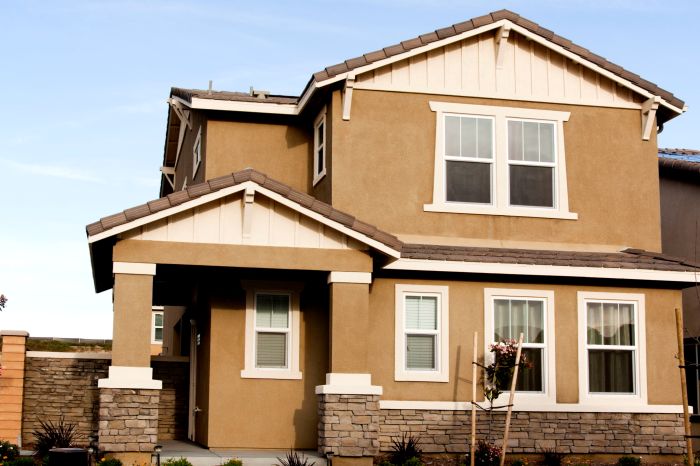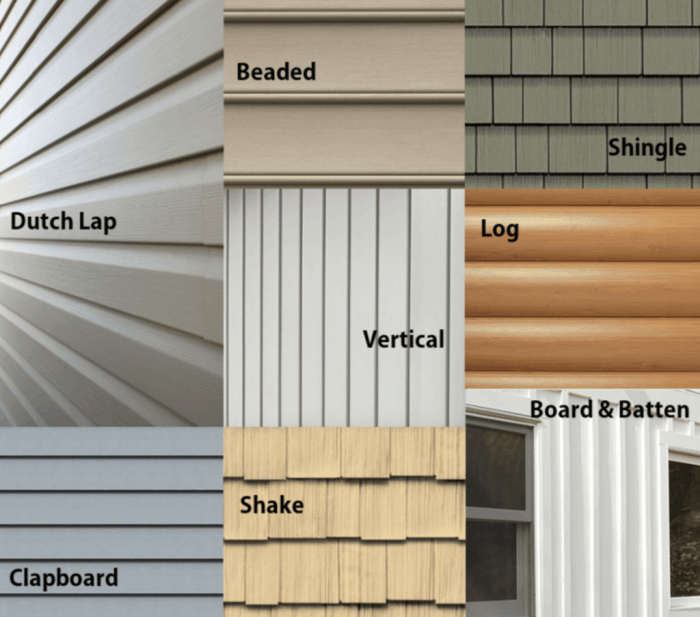Unique exterior material options take center stage in the realm of architecture and design, offering a fresh perspective on traditional building materials. From eco-friendly choices to high-tech innovations, the possibilities are endless. Let’s dive into the world of unconventional materials that are reshaping the way we approach exterior design.
Unique exterior material options
Using unconventional materials for the exterior of a building offers numerous benefits, from increased sustainability to unique aesthetic appeal. These materials can push the boundaries of traditional architecture and create visually striking structures that stand out from the crowd.
Innovative Exterior Materials
Innovations in architecture have led to the rise of various unique exterior materials that are gaining popularity in the industry. Some examples include:
- Bio-concrete made with living bacteria that can self-heal cracks over time.
- Transparent wood that combines the strength of traditional wood with the transparency of glass.
- Recycled plastic panels that offer a sustainable alternative to traditional building materials.
- 3D-printed concrete that allows for complex and intricate designs to be easily created.
Enhancing Aesthetics with Unique Materials, Unique exterior material options
Unique materials have the power to enhance the aesthetics of a structure by adding texture, color, and visual interest. Incorporating unconventional materials can help architects and designers create truly one-of-a-kind buildings that make a statement and leave a lasting impression on viewers.
Challenges and Considerations
When selecting non-traditional materials for exteriors, there are several challenges and considerations to keep in mind. These may include:
- Durability and longevity of the material in different weather conditions.
- Maintenance requirements and potential repair costs over time.
- Compatibility with existing building systems and structures.
- Cost implications and budget constraints for using innovative materials.
Sustainable exterior material choices: Unique Exterior Material Options

When it comes to sustainable exterior material choices, there are several eco-friendly options that not only contribute to sustainability but also offer benefits in terms of durability and environmental impact compared to traditional materials. These sustainable options are crucial in green building practices and can significantly improve energy efficiency in buildings.
Eco-Friendly Exterior Material Options
There are various sustainable exterior material choices available that can help reduce the environmental impact of construction and improve the overall sustainability of buildings. Some examples include:
- Bamboo: Bamboo is a rapidly renewable resource that can be used for exterior cladding, decking, and fencing. It is durable, lightweight, and has a low carbon footprint.
- Recycled Metal: Using recycled metal for exterior siding and roofing can help reduce energy consumption and greenhouse gas emissions associated with traditional metal production.
- Cork: Cork is a sustainable material that can be used for exterior wall finishes. It is a renewable resource harvested from the bark of cork oak trees without causing harm to the tree.
Comparison of Durability and Environmental Impact
When comparing sustainable exterior materials to traditional ones, sustainable options often prove to be more durable and have a lower environmental impact. For example, bamboo is known for its strength and longevity, making it a reliable choice for exterior applications. Additionally, using recycled materials reduces the need for new resource extraction and minimizes waste sent to landfills.
Remember to click Exterior paint color schemes to understand more comprehensive aspects of the Exterior paint color schemes topic.
Green Building Certifications
There are several green building certifications that focus on sustainable exterior materials and construction practices. Some of the prominent certifications include:
- LEED (Leadership in Energy and Environmental Design): LEED certification recognizes buildings that meet high standards of sustainability, including the use of eco-friendly exterior materials.
- Green Globes: Green Globes certification evaluates the environmental performance of buildings and encourages the use of sustainable materials in construction.
Improving Energy Efficiency
By choosing sustainable exterior materials, buildings can improve their energy efficiency in various ways. For instance, materials like cork and bamboo have natural insulation properties that can help regulate indoor temperatures and reduce the need for heating and cooling systems. This not only lowers energy consumption but also contributes to a healthier indoor environment.
High-tech exterior material innovations

In today’s rapidly advancing technological landscape, high-tech exterior materials are revolutionizing the construction industry. These innovative materials offer a wide range of benefits, from enhanced functionality to improved performance and safety of structures.
Integration of Smart Materials
Smart materials, also known as intelligent or responsive materials, are designed to react to changes in their environment. These materials can adjust their properties based on external stimuli such as temperature, light, or moisture. When integrated into building exteriors, smart materials can provide self-healing capabilities, energy efficiency, and even shape-shifting features. For example, self-healing concrete can repair cracks on its own, increasing the lifespan of the structure and reducing maintenance costs.
Enhanced Functionality and Performance
High-tech exterior materials are engineered to enhance the functionality and performance of buildings. For instance, photovoltaic glass panels can be used as both windows and solar panels, harnessing solar energy to generate electricity while allowing natural light to enter the building. These advancements not only contribute to sustainability but also reduce energy costs for building owners.
Improved Safety Measures
The incorporation of high-tech materials in building exteriors can significantly improve safety measures. For example, fire-resistant materials like advanced composite panels can help prevent the spread of fires in case of emergencies, protecting both the building occupants and surrounding structures. Additionally, materials with enhanced durability and weather resistance can withstand harsh environmental conditions, ensuring the longevity and structural integrity of the building.
Cost Implications
While the initial cost of incorporating high-tech exterior materials may be higher than traditional options, the long-term benefits often outweigh the upfront investment. Energy-efficient materials can lead to reduced utility bills, while durable materials require less maintenance and replacement over time. Moreover, the increased functionality and safety provided by high-tech materials can result in savings on insurance premiums and potential disaster recovery costs.
Overall, the cost implications of using high-tech exterior materials in construction projects are balanced by the numerous advantages they offer in terms of sustainability, performance, and safety.
Cultural influences on exterior material choices

In architecture, cultural influences play a significant role in determining the materials used for building exteriors. These influences can stem from a region’s heritage, traditions, beliefs, and even the availability of resources. By incorporating cultural elements into exterior designs, architects and designers can create spaces that not only reflect the identity of a community but also contribute to a sense of belonging and pride.
Impact of Cultural Traditions on Material Selection
Cultural traditions have a profound impact on the selection of materials for building exteriors. For example, in Japan, traditional houses are often constructed using wood and bamboo, materials that have been used for centuries due to their abundance and sustainability. The intricate craftsmanship and attention to detail in Japanese architecture reflect the cultural value placed on nature and simplicity.In contrast, the adobe buildings in the southwestern United States showcase the influence of Native American culture on material choices.
Adobe, a mixture of clay, sand, straw, and water, is a sustainable and energy-efficient material that has been used by indigenous peoples for generations. The earthy tones and organic textures of adobe buildings blend harmoniously with the desert landscape, highlighting the connection between architecture and the natural environment.
Significance of Cultural Elements in Modern Designs
Incorporating cultural elements in modern exterior designs not only pays homage to the past but also creates a sense of continuity and identity in contemporary architecture. By reinterpreting traditional materials and techniques in innovative ways, architects can bridge the gap between history and modernity, creating spaces that resonate with people on a cultural level.For instance, the use of traditional Moroccan zellige tiles in modern facades adds a touch of authenticity and richness to contemporary buildings.
These colorful, geometric tiles are handcrafted by skilled artisans using centuries-old techniques, showcasing the beauty of Moroccan craftsmanship and design heritage in a modern context.
Inspiration for Creativity and Diversity in Material Choices
Cultural influences can inspire creativity and diversity in exterior material choices by encouraging designers to think outside the box and explore new possibilities. By drawing from different cultural traditions and aesthetics, architects can create unique and visually striking facades that tell a story and evoke emotions.For example, the incorporation of intricate lace patterns inspired by Belgian lacework in contemporary metal facades adds a layer of elegance and sophistication to urban landscapes.
This fusion of traditional craftsmanship with modern materials exemplifies how cultural influences can spark innovation and push the boundaries of design.